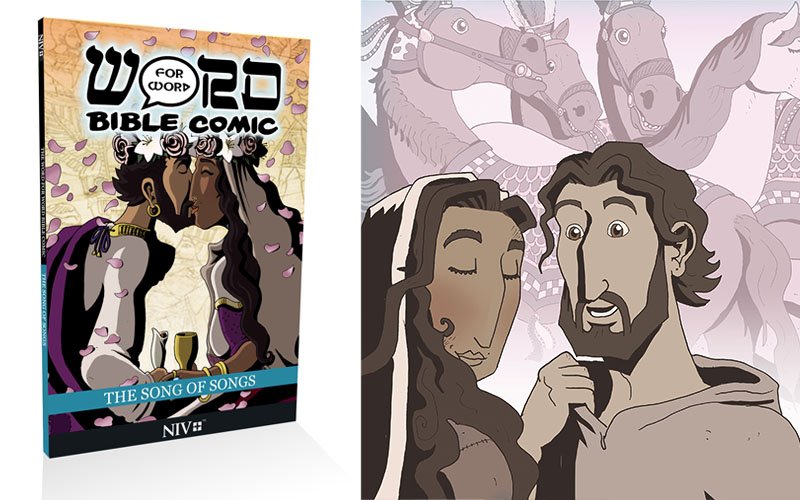WHAT DO THE IDIOMS IN SONG OF SONGS MEAN?
While some of the idioms and comparisons in the Song of Songs are clear like the scent of incense and flowers, others can seem perplexing. Below is a list of some of the key idioms used in the books and notes on what commentators believe they refer to. An important note is that the references are not always what things look like but their strengths or characteristics.
Mare (1:9-11): It's believed that Pharaoh's chariots would have been drawn exclusively by stallions, so a mare among them implies she is extremely diverting. A battle tactic attested in Egyptian literature was to release a mare in the vicinity of an enemy’s chariots so that the stallions pulling the chariots would become distracted and chaotic. An alternative interpretation that supposes a mare is pulling Pharaoh's chariot suggests that she looks majestic in the finery of a royal chariot horse. (See image, facing page.)
Earrings of gold studded with silver (1:11): As in Proverbs 25:11, the image of a finely crafted piece of precious jewellery was commonly used in the Ancient Near East as a metaphor to demonstrate devotion and affection.
Lily of the Valley (2:1-2): The rose of Sharon and Lily of the Valley are small, everyday flowers, so it is believed that the woman is saying she is common and insignificant in comparison to other flowers/women. The man retorts to say that if she is a lily, by comparison, all other women are thorns.
Lilies (2:16, 4:5, 5:13, 6:2-3, 7:2): Some translators consider the lilies mentioned here to be lotus flowers, which were very important symbols of sensuality, fertility, and vitality in Egypt and Canaan.
Young stag/gazelle (2:9, 17, 8:14): The woman is likely referring to the strength, speed, and vitality of the animal, as well as the virility, in some cases. These animals could also be being used as a metaphor for love, as they were closely associated with a variety of love goddesses in the Ancient Near East.
My vineyard (2:15, 8:12): While a real vineyard is sometimes in view, many times her/your/our vineyard is referred to and means her love or something more physical.
Little foxes (2:15): In this verse "Catch for us the foxes, the little foxes that ruin the vineyards, our vineyards that are in bloom." it is difficult to know who is speaking, but generally the little foxes are thought to be other potential suitors who may come to burrow in or generally despoil her vineyard. She may be asking him to keep her safe from them, or he might be asking her to keep them away.
Dove's eyes (4:1, 5:12): While some doves have iridescent colors surrounding their eyes which could indicate her eye makeup, doves figure prominently on seals and other iconography as a symbol of lovemaking or seduction. They are sometimes understood as messengers of love. In this case, it is most likely that the eyes are being ascribed seductive power.
Goats (4:1): This description likely is visual as some breeds of goat have long glossy black coats.
Sheep (4:2): Newly shorn and washed sheep are very white, and "each having its twin” means that the woman is not missing any teeth. That is something that was not as common then as it is today.
Pomegranates (4:3,13, 6:7, 7:12, 8:2): "Your temples behind your veil are like the halves of a pomegranate.” This is a perplexing verse, but I discovered that the Hebrew רַקָּה translated “temples" could be substituted for cheeks, which makes much more sense. However, in chapters 6-8, it is more likely that “pomegranates" refers to breasts, based on the fruit's physical qualities.
Tower (4:4, 7:4): Perhaps a reference to being tall and slender as in contemporary art and literature from Egypt and Canaan, a long neck was a characteristic of a beautiful woman. This could also indicate strength.
Twin fawns (4:5, 7:3): This is one of the most obscure idioms to our ears. Few commentaries have satisfactory explanations for the image. However, the young twin fawns may represent youth and vitality as well as uniformity (twins).
Fountain/ stream (4:12, 15): In the hot climate of Israel streams of water make the land fertile, so fertility is likely the focus of these verses.
Mountains and hills of incense (4:6, 8:14): The most straightforward understanding of these verses is that the hills and mountains in question relate to her body.
Closed Garden (4:12,15-16, 5:1): Like the vineyard, the garden throughout the song seems to be a metaphor for her body. Solomon praises her for being a locked garden, to which she retorts that he may now come in. It seems to be a common metaphor of the period, as in Sumerian literature the term was often used as to describe the lover’s partner (i.e "you are a well-stocked garden”). In Akkadian proverbs, women are often described as “a garden of delight.” In Egyptian love songs, women often describe themselves as a garden or field abundant with all sorts of plants.
Sister (4:9-10): Sister is a generic friendly term for a woman, whether she is a blood relation or not.
Cedars (5:15, 8:9): The wood of cedar trees is renowned for their strength, beauty, and fragrance. This is a wood of luxury and quality.
Pools of Heshbon (7:4): Pools of water reflect the light and so function as an excellent metaphor for the beloved’s dazzling eyes. Excavations at Heshbon uncovered a large water cistern or reservoir from the eighth century B.C. that is highly likely to be the inspiration for this image. The city is located in a region that is arid during the summer, so the light reflecting off this cistern would have been a beautiful and reassuring sight.
Wall or a door (8:8-10): Her brothers sing about whether their little sister should be characterised as a wall or a door. A wall is designed to keep men out; a door is designed to open and let men in.
“Do not arouse or awaken love until it so desires.” (2:7, 3:5, 8:4): This repeated charge from the bride to the Daughters of Jerusalem (that is, the local women present at the wedding) is, I believe, the central theme of the book. This is a warning not to fall in love or become passionate with desire until the appropriate time, which would be in the context of marriage.
Lastly, while creating this book I noticed that in verses 5:11-13, the bride says of Solomon that "his hair is wavy and black as a raven … His lips are like lilies dripping with myrrh." I was interested to note that when Jesus speaks of King Solomon in Luke 12:22-34, he also uses ravens and lilies in his examples.
“Consider the ravens: They do not sow or reap, they have no storeroom or barn; yet God feeds them. [...] “Consider how the lilies grow. They do not labor or spin. Yet I tell you, not even Solomon in all his splendor was dressed like one of these. If that is how God clothes the grass of the field, which is here today, and tomorrow is thrown into the fire, how much more will he clothe you—you of little faith!"
We hope you’ve learnt something from this, and enjoyed reading it.
The graphic novel of Song of Songs is out now and you can order a copy from our website:



